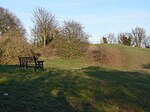Owston Ferry
Civil parishes in LincolnshireUse British English from February 2014Villages in the Borough of North Lincolnshire

Owston Ferry is a village and civil parish in North Lincolnshire, England. It is situated on the west bank of the River Trent, and 9 miles (14 km) north from Gainsborough. It had a total resident population of 1,128 in 2001 including Kelfield. This increased to 1,328 at the 2011 census. Sometimes referred to as Owston or Ferry, the village forms part of the Isle of Axholme. It is bounded to the west by the A161 road and the village of Haxey. The River Trent is directly to the east. To the north, beyond a number of hamlets and villages, lies the Humber estuary. West Butterwick was originally a part of the township of Owston.
Excerpt from the Wikipedia article Owston Ferry (License: CC BY-SA 3.0, Authors, Images).Owston Ferry
Burnham Road,
Geographical coordinates (GPS) Address Nearby Places Show on map
Geographical coordinates (GPS)
| Latitude | Longitude |
|---|---|
| N 53.495228 ° | E -0.785656 ° |
Address
Burnham Road
Burnham Road
DN9 1AY
England, United Kingdom
Open on Google Maps










